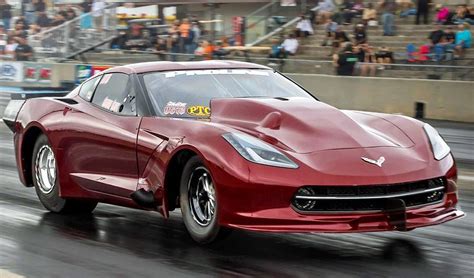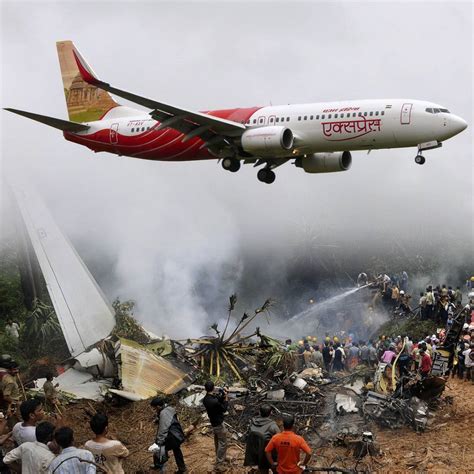
A heart-stopping moment unfolded at the Holley LS Fest East in Bowling Green, Kentucky, as a C7 Corvette, driven by Blake Copson, became airborne during a drag racing event, soaring several feet into the air before landing heavily. The incident, captured on video, quickly went viral, leaving spectators and online viewers in awe and prompting discussions about safety measures in motorsports.
The dramatic flight occurred during a race where Copson was competing. The Corvette, launching with significant power, experienced an unforeseen aerodynamic phenomenon, lifting the front end off the ground. “The car got way out of shape, and the front end lifted, and it went into the air,” Copson recounted, describing the chaotic situation. The vehicle then impacted the ground with considerable force, causing visible damage, yet, remarkably, Copson emerged unscathed.
The video footage, widely circulated on social media platforms and automotive news outlets, shows the Corvette accelerating down the drag strip when suddenly its front wheels lift dramatically. The car ascends several feet into the air before briefly hovering and then violently crashing back down. The immediate aftermath saw Copson regaining control and bringing the damaged vehicle to a stop.
This incident has sparked a widespread debate within the racing community regarding the factors that contribute to such occurrences and the preventative measures that can be implemented to mitigate risks. Aerodynamic instability, high horsepower, and track conditions are being closely examined to understand the physics behind the Corvette’s unexpected flight.
Detailed Account of the Incident
The Holley LS Fest East, an annual event celebrating vehicles powered by LS engines, draws thousands of participants and spectators to Beech Bend Raceway in Bowling Green. The event features a variety of racing activities, including drag racing, autocross, and drifting. It is renowned for its high-octane atmosphere and the impressive display of modified vehicles.
Blake Copson, an experienced racer, was participating in the drag racing segment with his C7 Corvette. Drag racing involves accelerating over a short, straight course, typically a quarter-mile, with the goal of achieving the fastest time. The sport demands immense power, precise control, and a thorough understanding of vehicle dynamics.
As Copson launched his Corvette, the vehicle’s immense power, combined with aerodynamic factors, caused the front end to lift unexpectedly. “I was just trying to go fast, and things got a little out of hand,” Copson admitted in an interview following the incident. The Corvette ascended rapidly, becoming airborne for a brief but terrifying moment.
The impact upon landing was forceful, causing damage to the vehicle’s front end and undercarriage. Despite the severity of the impact, Copson managed to maintain control and bring the car to a safe stop. Medical personnel were immediately on the scene, but Copson declined medical attention, confirming that he was uninjured.
“I’m okay, just a little shaken up,” Copson stated. “The car took the brunt of it.”
Reactions and Aftermath
The video of the Corvette’s airborne escapade quickly went viral, generating significant buzz within the racing community and beyond. Spectators who witnessed the event firsthand described a mix of shock and awe. “It was unbelievable,” said one attendee. “I’ve never seen anything like it. One minute, he was racing, and the next, he was flying.”
Online forums and social media platforms were flooded with comments and discussions about the incident. Many praised Copson’s driving skills in managing to control the vehicle after the hard landing. Others raised concerns about the safety of drag racing and the potential for such incidents to occur.
Racing experts and engineers have weighed in on the possible causes of the Corvette’s flight. Aerodynamic lift, caused by air flowing under the car at high speed, is believed to be a primary factor. The angle of attack, the shape of the vehicle’s underbody, and the presence of aerodynamic aids can all influence the amount of lift generated.
High horsepower, a hallmark of LS-powered vehicles, also plays a significant role. The immense acceleration can exacerbate aerodynamic instability, making it more difficult to control the vehicle. Track conditions, such as uneven surfaces or changes in elevation, can further contribute to such incidents.
In the wake of the incident, racing organizations and sanctioning bodies are likely to review safety regulations and procedures. Measures to mitigate the risk of similar occurrences could include enhanced aerodynamic testing, improved track maintenance, and stricter vehicle inspection protocols.
Expert Analysis and Preventative Measures
Aerodynamic instability is a complex phenomenon that can affect any high-speed vehicle. In the case of the Corvette, the combination of high horsepower and aerodynamic factors created a perfect storm. The vehicle’s front end likely acted as an airfoil, generating lift as air flowed underneath it.
The angle of attack, the angle between the vehicle’s underbody and the oncoming airflow, is a critical determinant of lift. A steeper angle of attack can generate more lift, increasing the risk of an airborne event. The shape of the vehicle’s underbody, including the presence of diffusers or splitters, can also influence lift.
Aerodynamic aids, such as wings and spoilers, are commonly used in racing to generate downforce, which helps to keep the vehicle planted on the ground. However, these devices must be carefully designed and installed to be effective. Improperly designed or installed aerodynamic aids can actually increase lift or create other instability issues.
Track conditions can also play a significant role in aerodynamic stability. Uneven surfaces or changes in elevation can disrupt airflow and create unexpected lift. Regular track maintenance, including grading and smoothing, is essential to minimize these risks.
To prevent similar incidents from occurring in the future, racing organizations and teams can implement several preventative measures. These include:
- Enhanced Aerodynamic Testing: Conducting thorough wind tunnel testing and computational fluid dynamics (CFD) analysis to understand the aerodynamic characteristics of vehicles.
- Improved Track Maintenance: Regularly inspecting and maintaining track surfaces to ensure they are smooth and level.
- Stricter Vehicle Inspection Protocols: Implementing comprehensive vehicle inspection protocols to ensure that aerodynamic aids are properly designed and installed.
- Driver Training: Providing drivers with specialized training on how to recognize and respond to aerodynamic instability.
- Speed Limitations: Considering speed limitations or restrictions on certain types of vehicles or tracks.
- Active Suspension Systems: The use of active suspension systems that automatically adjust to maintain optimal ride height and reduce the likelihood of the front end lifting.
- Wheelie Bars: Integrating wheelie bars as standard safety equipment, especially in high-horsepower drag racing applications, to prevent excessive front-end lift.
- Aerodynamic Modifications: Mandating specific aerodynamic modifications such as front splitters and rear diffusers to improve downforce and reduce the potential for lift.
- Data Acquisition Systems: Utilizing data acquisition systems to monitor vehicle dynamics and identify potential issues before they escalate.
The Broader Context of Racing Safety
The Corvette incident serves as a reminder of the inherent risks involved in motorsports. Racing is a high-speed, high-stakes activity that demands precision, skill, and a thorough understanding of vehicle dynamics. While safety technology and regulations have significantly improved over the years, accidents can still happen.
Racing organizations and sanctioning bodies have a responsibility to ensure the safety of drivers, spectators, and event personnel. This includes implementing comprehensive safety regulations, conducting thorough vehicle inspections, and providing adequate medical support.
Drivers also have a responsibility to operate their vehicles safely and responsibly. This includes adhering to all safety regulations, maintaining their vehicles in good condition, and driving within their limits.
Spectators play a role in racing safety as well. By following safety guidelines and remaining in designated viewing areas, spectators can help to minimize the risk of injury.
The pursuit of speed and performance in motorsports often pushes the boundaries of what is possible. However, it is essential to balance the desire for excitement with the need for safety. By prioritizing safety and implementing effective preventative measures, the racing community can help to minimize the risk of accidents and ensure that the sport remains safe and enjoyable for all.
Conclusion
The airborne Corvette incident at Holley LS Fest East was a dramatic and unforgettable event. While the incident could have had serious consequences, fortunately, the driver emerged unharmed. The incident has sparked a valuable discussion about safety in motorsports and the importance of understanding and mitigating aerodynamic risks.
By learning from this experience and implementing effective preventative measures, the racing community can work to ensure that such incidents become less frequent in the future. The goal is to continue to push the boundaries of performance while maintaining a safe and responsible environment for all participants.
Frequently Asked Questions (FAQ)
1. What caused the Corvette to go airborne during the drag race?
The primary cause was likely a combination of high horsepower and aerodynamic factors. The Corvette’s powerful engine generated immense acceleration, and the vehicle’s front end acted as an airfoil, generating lift as air flowed underneath it. This, combined with the angle of attack and track conditions, resulted in the front end lifting dramatically.
2. Was the driver, Blake Copson, injured in the incident?
No, Blake Copson emerged from the incident unharmed. He declined medical attention at the scene, stating that he was “okay, just a little shaken up.” The vehicle absorbed most of the impact.
3. What is Holley LS Fest East?
Holley LS Fest East is an annual event held at Beech Bend Raceway in Bowling Green, Kentucky. It celebrates vehicles powered by LS engines and features a variety of racing activities, including drag racing, autocross, and drifting.
4. What measures can be taken to prevent similar incidents from happening in the future?
Several preventative measures can be implemented, including enhanced aerodynamic testing, improved track maintenance, stricter vehicle inspection protocols, driver training, speed limitations, and the use of active suspension systems and wheelie bars. Modifying vehicle aerodynamics to increase downforce is also crucial.
5. What is the racing community’s reaction to the incident?
The racing community’s reaction has been a mix of shock, awe, and concern. Many have praised Copson’s driving skills in managing to control the vehicle after the hard landing. Others have raised concerns about the safety of drag racing and the potential for such incidents to occur. The incident has sparked a widespread debate about safety regulations and preventative measures in motorsports.









